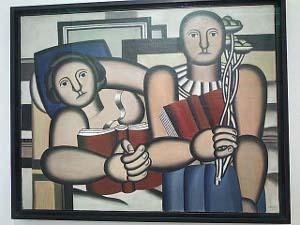 Leger's La Lecture
speaking. To enter the Pompidou Museum, you cross a large plaza and enter a lobby containing signs to boutiques, cinemas and Spectacles; La Musee is only one attraction among several. The museum is on the top floors.
Leger's La Lecture
speaking. To enter the Pompidou Museum, you cross a large plaza and enter a lobby containing signs to boutiques, cinemas and Spectacles; La Musee is only one attraction among several. The museum is on the top floors.
The Industrial-Modern design of Le Centre Pompidou is just about as far away as one can get from the elegant spread of the Louvre, architecturally  Leger's La Lecture
speaking. To enter the Pompidou Museum, you cross a large plaza and enter a lobby containing signs to boutiques, cinemas and Spectacles; La Musee is only one attraction among several. The museum is on the top floors.
Leger's La Lecture
speaking. To enter the Pompidou Museum, you cross a large plaza and enter a lobby containing signs to boutiques, cinemas and Spectacles; La Musee is only one attraction among several. The museum is on the top floors.
The goal for today was to see the Surrealist art, which occupies a very small space in the Parisian art world. Here the Magritte and Breton and Dali and Tanguy works are contained within the gallerys of art 1906 - 1960. The overall collection in this gallery is dazzling. There are dozens of Braques, a multitude of Picassos many of which were unfamiliar, some early and vibrant Dali paintings, and what seems to be an entire roomful of Leger works. Two small side galleries show silent films created by painters of the 1930s.
 Large galleries
Large galleries
One additional major attraction is an entire wall representing Andre Breton's studio. One of the founders of the surrealist movement (and one of the people who named it), Breton lived in a small Paris studio for many years, filling it with objects he would find in his wanderings, and enjoying the juxtaposition of unlikely objects. After his death, when the studio was sold, the contents were provided to the Centre Pompidou and arranged in memory of him, with the help of relatives. It's a charming portrait of an artist.
The gallery rooms are large, well-lit and uncrowded, and the views from the top floor are splendid. One of the great benefits of visiting this museum is seeing just about all of Paris spread out beyond the Centre (although the terraces, which appear to have been designed for public use, are currently locked off).
 The Pompidou terrace
The Pompidou terrace
Art does make us hungry. Rejecting the rooftop restaurant, where the prices seemed to be elevated to match the view instead of the quality of the cuisine, we descended. There was a grim-looking cafeteria on a lower floor, which we also passed, and were rewarded by a sidewalk bar and cafe with a tasty boeuf bourgignon. Just in time, too for one of yesterday's rainsqualls passed over the neighborhood, ending conveniently at the same time as the luncheon.
It was interesting to learn that there are enough English readers in Paris to justify a branch of Brentano's bookstores. We saw stacks of Harry Potter and Hilary Clinton, along with the paperback of Q is for Quarry, the latest mystery by Sue Grafton.